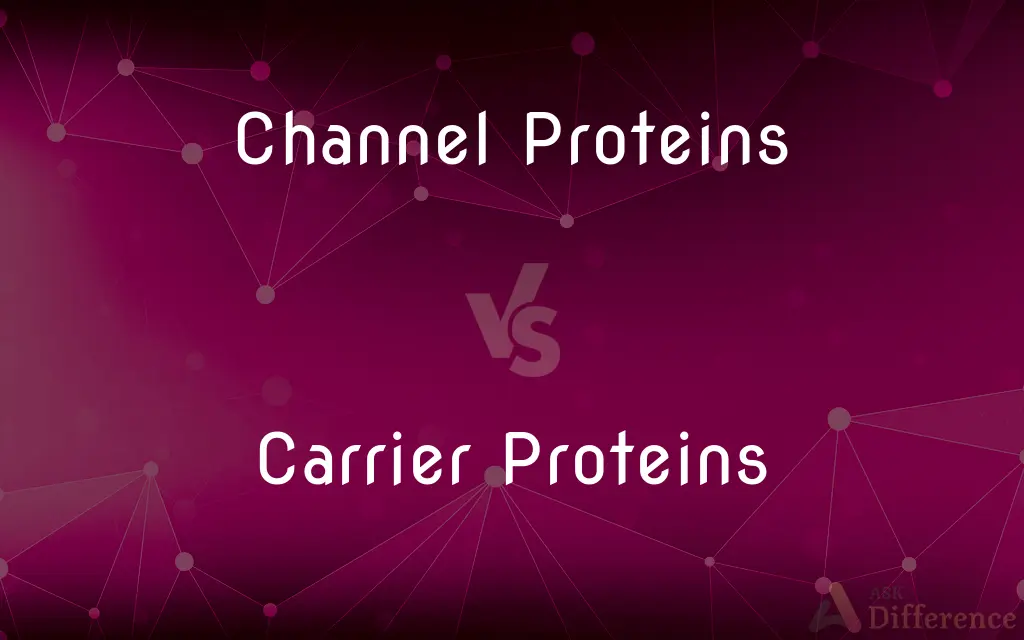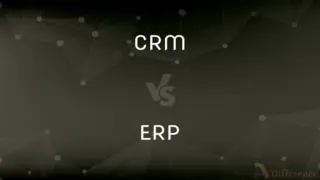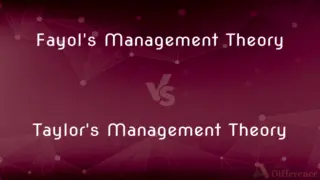Channel Proteins vs. Carrier Proteins — What's the Difference?
Edited by Tayyaba Rehman — By Fiza Rafique — Published on December 9, 2023
Channel proteins form pores in cell membranes for substances to passively flow through, while carrier proteins bind and transport specific molecules, often requiring energy.

Difference Between Channel Proteins and Carrier Proteins
Table of Contents
ADVERTISEMENT
Key Differences
Channel proteins are integral membrane proteins that create a tunnel or pathway in the cell membrane, whereas carrier proteins change shape to transport specific molecules across the membrane.
Both channel proteins and carrier proteins play pivotal roles in cellular transport; channel proteins allow the passive movement of ions and small molecules, while carrier proteins may require energy for active transport of specific substances.
Channel proteins can be always open or gated, responding to various stimuli to either open or close. In contrast, carrier proteins undergo conformational changes to move substances across the membrane.
In some cases, channel proteins facilitate the rapid movement of ions, helping maintain electrical gradients. Carrier proteins, on the other hand, often transport larger molecules like glucose or amino acids against their concentration gradient.
While channel proteins are crucial for processes like nerve transmission due to their quick transport mechanism, carrier proteins ensure that cells receive essential nutrients even from low-concentration areas.
ADVERTISEMENT
Comparison Chart
Mechanism of Action
Form pores or tunnels
Bind to and transport molecules
Energy Requirement
Usually passive (no energy)
Can be passive or active (requiring energy)
Response
Can be always open or gated
Undergo conformational changes
Types of Molecules Transported
Ions and small molecules
Larger molecules like glucose and amino acids
Speed of Transport
Rapid due to open pathway
Can be slower due to binding and conformational change process
Compare with Definitions
Channel Proteins
Essential for maintaining cellular electrical gradients.
Ion channel proteins help in balancing the charge inside and outside the cell.
Carrier Proteins
Can move substances in both directions based on concentration gradients.
Carrier proteins can both take in nutrients from the extracellular space and expel waste products.
Channel Proteins
Integral membrane proteins forming pathways.
Channel proteins in neurons aid in transmitting electrical signals.
Carrier Proteins
Bind to specific molecules for transport.
Carrier proteins ensure glucose enters cells where it's needed for energy.
Channel Proteins
Facilitate rapid transport of specific ions or molecules.
Potassium channel proteins allow the quick movement of potassium ions across cell membranes.
Carrier Proteins
Often involved in active transport.
Some carrier proteins use energy to transport molecules against their concentration gradient.
Channel Proteins
Can be gated or always open.
Voltage-gated channel proteins open or close in response to changes in membrane potential.
Carrier Proteins
Undergo shape changes during transport.
Upon binding its substrate, a carrier protein changes shape to release the molecule inside the cell.
Channel Proteins
Permit passive flow of molecules.
Water moves through the cell membrane via channel proteins called aquaporins.
Carrier Proteins
Specific for the substances they transport.
A carrier protein for sodium ions won't transport potassium ions.
Common Curiosities
Are channel proteins specific to the ions they transport?
Yes, specific channel proteins allow the passage of specific ions like potassium or sodium.
Can channel proteins be regulated?
Yes, some channel proteins are gated and can open or close in response to stimuli.
What triggers the shape change in carrier proteins?
The binding of the specific molecule or ion to the carrier protein triggers its shape change.
Can toxins affect channel proteins?
Yes, some toxins can block or alter channel protein function, affecting cellular processes.
Do carrier proteins always require energy for transport?
No, while some carrier proteins perform active transport requiring energy, others work passively.
What regulates the opening and closing of gated channel proteins?
Gated channel proteins can be regulated by voltage changes, ligand binding, or other mechanisms.
What is the primary function of channel proteins?
Channel proteins create pathways in cell membranes for substances to move through passively.
How do carrier proteins differ from channel proteins in transport?
Carrier proteins bind to specific molecules and change shape to transport them, often requiring energy.
Do both channel and carrier proteins span the cell membrane?
Yes, both channel and carrier proteins are integral membrane proteins, spanning the cell membrane.
How do channel proteins affect nerve transmission?
Channel proteins allow rapid ion flow, crucial for transmitting electrical signals in neurons.
Can carrier proteins transport large molecules?
Yes, carrier proteins can transport larger molecules like glucose and amino acids.
Why are channel proteins essential for maintaining cellular electrical balance?
Channel proteins regulate ion flow, helping maintain electrical gradients and cellular charge balance.
What's an example of a molecule transported by carrier proteins?
Glucose is one molecule often transported into cells by carrier proteins.
Are there any diseases linked to malfunctions in channel or carrier proteins?
Yes, certain genetic diseases or conditions can arise from malfunctions in these proteins, like cystic fibrosis.
How does the cell control the direction of transport via carrier proteins?
The direction is determined by concentration gradients, and in active transport, energy direction.
Share Your Discovery

Previous Comparison
CRM vs. ERP
Next Comparison
Fayol’s Management Theory vs. Taylor’s Management TheoryAuthor Spotlight
Written by
Fiza RafiqueFiza Rafique is a skilled content writer at AskDifference.com, where she meticulously refines and enhances written pieces. Drawing from her vast editorial expertise, Fiza ensures clarity, accuracy, and precision in every article. Passionate about language, she continually seeks to elevate the quality of content for readers worldwide.
Edited by
Tayyaba RehmanTayyaba Rehman is a distinguished writer, currently serving as a primary contributor to askdifference.com. As a researcher in semantics and etymology, Tayyaba's passion for the complexity of languages and their distinctions has found a perfect home on the platform. Tayyaba delves into the intricacies of language, distinguishing between commonly confused words and phrases, thereby providing clarity for readers worldwide.











































